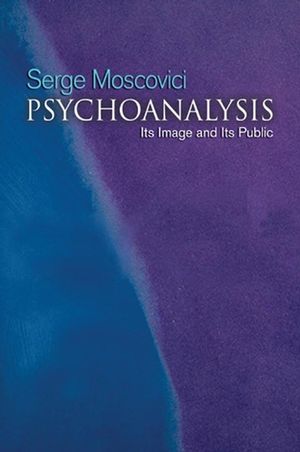Psychoanalysis: Its image and its publicISBN: 978-0-7456-3269-8
Paperback
416 pages
February 2008, Polity
 |
||||||
Preface by Daniel Lagache
Foreword to the Second Edition
Preliminary Remarks
Part One
The Social Representation of Psychoanalysis
Findings of Survey and Theoretical Analysis
Chapter One Social Representation: A Lost Concept
1 Miniatures of Behaviour, Copies of Reality and Forms of Knowledge
2 Philosophies of Indirect Experience
3 In What Sense is a Representation Social?
Chapter Two Psychoanalysis as She is Spoken
1 The Presence of Psychoanalysis
2 The Taboo on Communications and the Attractions of Ignorance
Chapter Three Ideas That Become Common-Sense Objects
1 Objectification
2 From Theory to Social Representation
3 The Materialisation of Concepts
Chapter Four ‘Homo Psychanalyticus’
1 Classifying and Naming
2 The Internal Boundary Between the Normal and the Pathological
3 Who Needs Psychoanalysis?
Chapter Five A Marginal Hero
1 The Psychoanalyst: Magician or Psychiatrist?
2 Social Relations and Role-Playing
3 How the Audience sees the Actor
Chapter Six The Psychoanalysis of Everyday Life
1 Description of the Second Major Process: Anchoring
2 Current activities courante and Analytic Therapy
3 Self-Analysts
Chapter Seven A Freud for All Seasons
1 The Need for Analysis
2 The Extent of Psychoanalysis’s domains of application
3 Does Psychoanalysis Work?
Chapter Eight Ideologies and Their Discontents
1 Psychoanalysis, Religion and Politics
2 The Values of Private Life
Chapter Nine Of Jargon in General and Franco-Analytic Jargon in Particular
1 Language and Languages in Conflict
2 Speech Becomes a Reality
Chapter Ten Natural Thought: Observation Made In the Course of Interviews
1 Phenomenological Remarks
2 The Style of Natural Thought
3 Two Principles of Intellectual Organisation
4 The Collective Intellect: Tower of Babel or Well-Ordered Diversity?
Part Two
Psychoanalysis and the French Press
Content Analysis and Analysis of Systems of Communication
Chapter One The Press: Overview
1 Who Talks about Psychoanalysis?
2 The Many Faces of Psychoanalysis
3 Attitudes, Groups and Ideological Orientations
Chapter Two The Diffusion of Psychoanalysis
1 First Descriptions
2 Rhetoric to the Fore
3 Language, The Fiction of Communication and impregnation
4 Overview
Chapter Three The Encounter Between Religious Dogma and
Psychoanalytic Principles
1 Propagation: Its Characteristics and Its Domain
2 The Assimilation and Adaptation of Profane Notions
3 In Search of a Catholic Conception of Psychoanalysis
Chapter Four The Communist Party Meets a Science that is Very Popular and Non-Marxist
1 Theoretical Perspectives
2 What Can We Expect to Read in a Communist or Progressive Publication?
3 What Anti-Psychoanalytic Propaganda Are We Talking About?
Chapter Five A Psychosociological Analysis of Propaganda
1 The Functions of Propaganda
2 Cognitive Aspects and Representation in Propaganda
3 Representation As a Tool for Action
4 Language and Action
5 Final Observations
Fifteen Years Later
Chapter Six A Hypothesis
Afterword
Appendix
Bibliography



